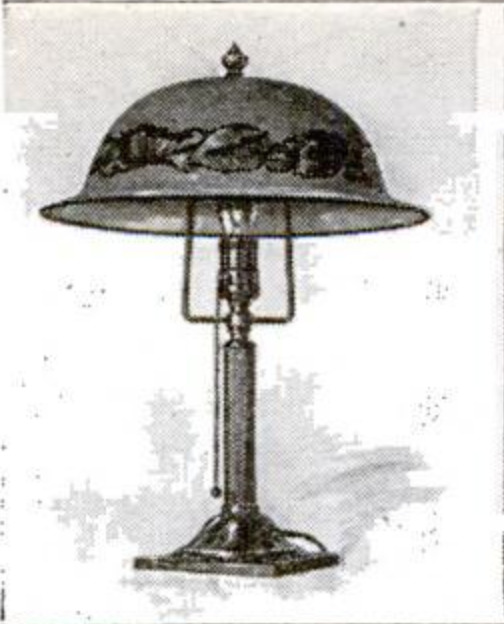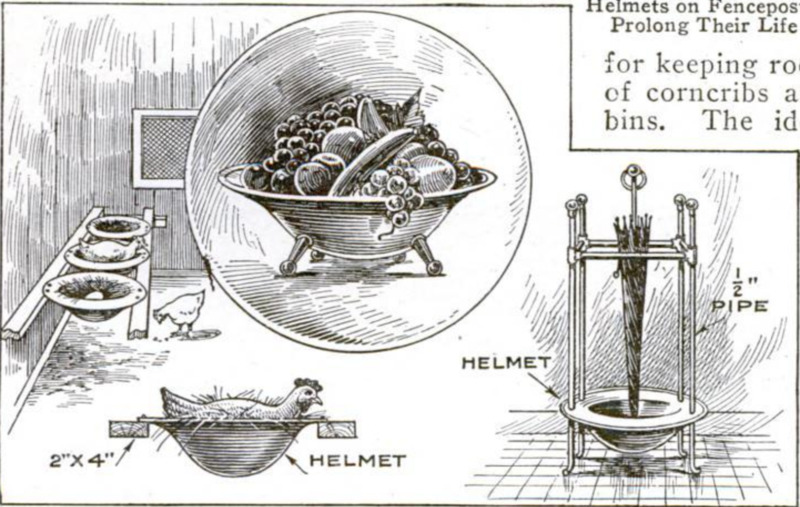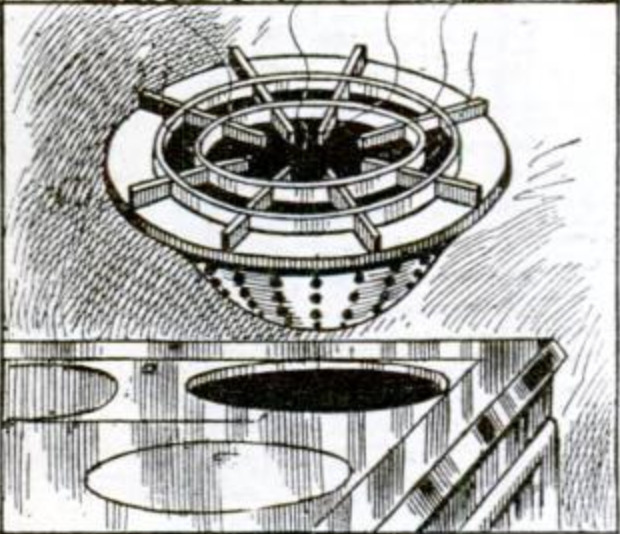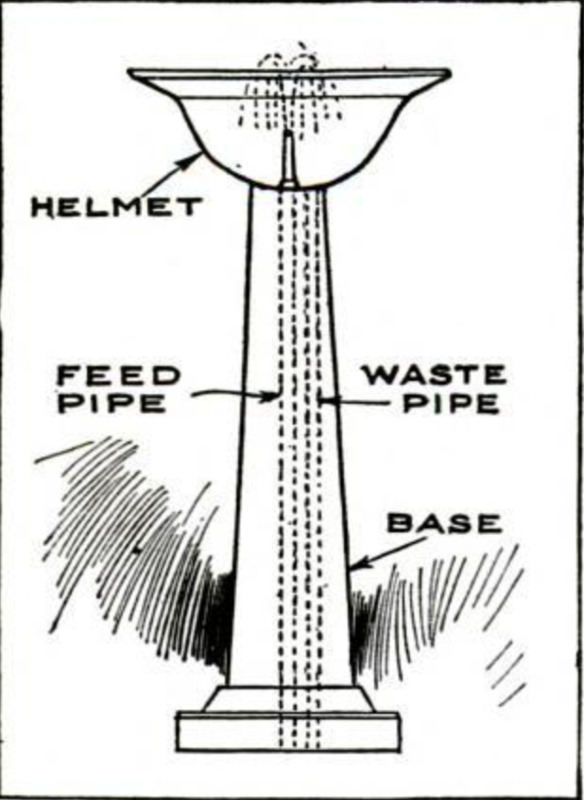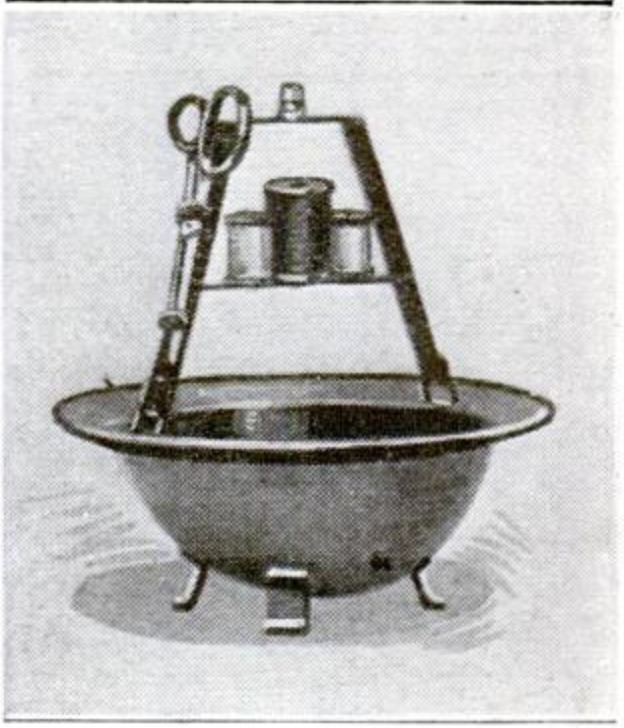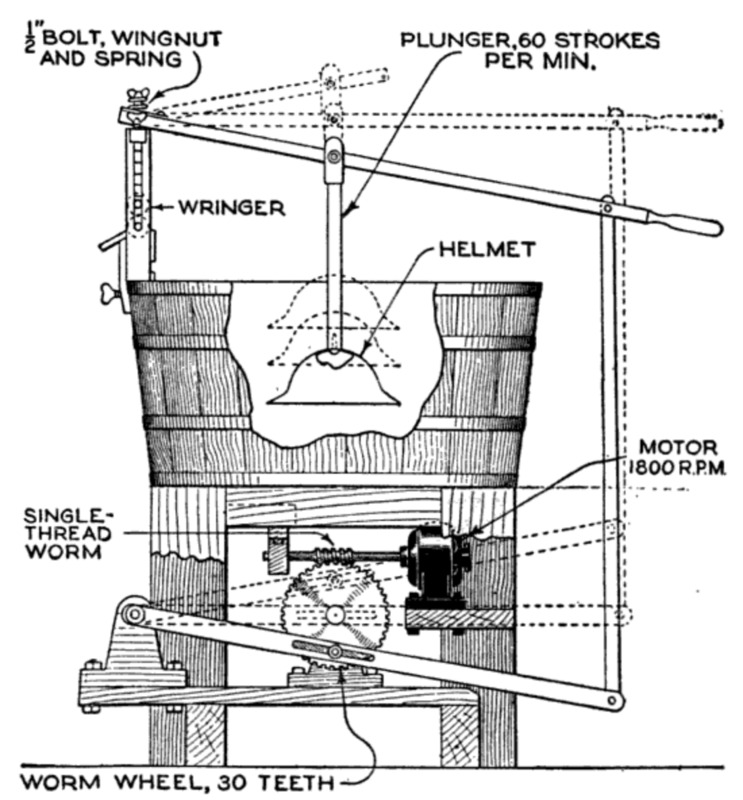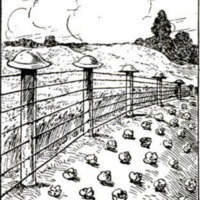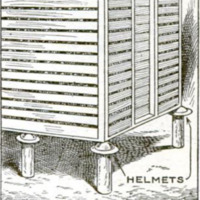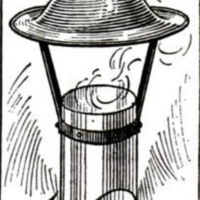-
Title (Dublin Core)
-
Utilizing New Steel Trench Helmets
-
Article Title and/or Image Caption (Dublin Core)
-
Utilizing New Steel Trench Helmets
-
extracted text (Extract Text)
-
Fruit Dish, Poultry Nest, and Umbrella Stand Made from Helmets
The three ideas illustrated in the large drawing, the fruit dish, poultry nest, and umbrella stand, were submitted by J. V. Romig, of Allentown, Pa. The fruit dish is supported on feet, about 1½ in. long, turned from brass rod. These feet are inserted into holes drilled through the helmet, and riveted, the finished article being decorated in any desired manner, and then lacquered. Parasites that infest wooden nest boxes refuse to have anything to do with metal nests. Consequently, by mounting trench helmets in the manner shown, the general condition of the flock will be improved. The steel nests are indestructible, and, having no corners or crevices, easily cleaned. A trench helmet will make an admirable drip bowl for an umbrella stand. The frame is made from ½-in. pipe and fittings, of polished brass, nickeled brass, copper, or painted iron. Holes are drilled in the rim of the helmet to slip over the pipe standards, where it is held in place with cotter pins. The small hole in the center of the crown in may be plugged, so that, by removing the plug, water from the dripping umbrellas can be drained off without removing the helmet.
Helmets Keep Rats Out of Corncrib
Truman R. Hart, of Ashtabula, Ohio, who won the third prize of the contest with his idea of utilizing helmets for bird baths, also contributed another plan that makes use of them
for keeping rodents and other vermin out of corncribs and similar elevated storage bins.
The idea involves nothing more complicated than capping each of the supporting posts with a trench helmet that has been drilled with two or three holes so that spikes can be driven through the plate into the post.
Fenceposts Preserved by Helmets
From saving the lives of soldiers on the battlefield, the trench helmets have been adapted by R. C. Leibe, of Chase City, Va., to prolonging the life and usefulness of fenceposts on the farm. The drawing shows how each post is surmounted by a helmet that is held in place with a long spike. Naturally, this protection prevents water, that would cause the post to check and split within a comparatively short number of seasons, from coming into contact with the exposed end.
Trench Helmet as Charcoal Brazier
A rather original idea in which a trench helmet is used as a charcoal brazier in the
kitchen stove during the heat of summer, is the contribution of Roland B. Cutler Springfield, Vt. The crown of the helmet is perforated with ¼-in. holes to permit circulation of air through the burning charcoal that is placed inside. In use, the helmet is set into one of the openings of the kitchen stove, and a grid from an oil or gas stove, resting upon a plate fastened to the rim, completes the arrangement.
A Helmet Drinking Fountain
From New Hartford, N. Y., Floyd A. Krenzer submitted his idea for making a sanitary drinking fountain, using the trench helmet as a receptacle for catching the waste water. The water-supply pipe, with a suitable nozzle at its upper end, comes through the center of the crown, while the overflow is carried off by a waste pipe that is arranged a little to one side of the center. The fountain is mounted on a pedestal, that can be made to correspond with its surroundings; in some instances, it might be found preferable to mount it on wall brackets.
Helmet for Stovepipe Cap
To prevent rain from blowing down a stovepipe chimney and causing it to rust to pieces rapidly, Anthony Jacobucci, Philadelphia, Pa., suggests that the army trench helmet be used as stovepipe caps in the manner shown in the drawing. A strip of flat, stiff iron is riveted around the stovepipe as a reinforcement for helmet-sup-porting braces, which are riveted to it and the helmet. Not only does a cap of this kind prevent entrance of rain, but, as the helmet is somewhat larger in diameter than the stovepipe, there is slight possibility of a down draft blowing the smoke out into the room below.
A Neat Sewing Stand
Arthur Gulbranson, of Chicago, Ill., has fashioned from a trench helmet a very substantial addition to the sewing equipment of the feminine portion of his family. As the photograph shows, feet. of ⅛ by 1-in. annealed brass strips, are riveted or soldered to the crown of the helmet. A combined spool rack and scissors holder, of the same material, is soldered in place, ⅜ by ⅞-in. brass pins being soldered to the crossbar to hold the spools. This crossbar has small projecting ears passed through slots in the sidepieces, soldered in place, then scraped bright. A clip and socket for • the scissors are also soldered to one of the sidepieces, and a small brass pin, soldered to the top of the rack,
makes a convenient holder for a thimble. The helmet and fittings were rubbed to a high polish with fine emery cloth and then lacquered, completing a very useful and substantial piece of work.
Trench-Helmet Washing Machine
A washing machine that can be operated by hand, or driven by electric motor, is the plan of Edwin J. Bachman, of Fullerton, Pa. He already has the hand-power machine in successful operation but plans to "motorize" it, so that it will be driven by a ¼-hp. electric motor. The hand-power machine is simplicity itself and consists of nothing more than a lever to which the trench-helmet vacuum plunger is attached. The hand lever is fastened to the top of the wringer by means of a bolt, wingnut, and spring, while the plunger with the trench helmet attached to its lower end swings freely on the hand lever, so that the former is always in a perpendicular position. If electric current and a ¼-hp. electric motor are available, it requires but little additional effort to make the motor do the work by following the arrangement shown in the drawing, the most important part of which is the gear and lever arrangement for reducing the speed of the motor and transmitting the motion to the helmet. The lower lever is slotted to fit over a crankpin in the larger gear; the center of the worm wheel must be directly below the center of the helmet, and the pivots on the slotted lever directly in line with those on the hand lever. Then, with the pin in the worm wheel 2 in. off center, the stroke of the plunger will be 4 in. It will be observed that with such an arrangement there will be more or less swinging of the plunger, whether operated by hand or power, but this is desirable because it permits the plunger to come down at a different point in the tub at almost every stroke.
-
Language (Dublin Core)
-
eng
-
Temporal Coverage (Dublin Core)
-
Interwar period
-
Date Issued (Dublin Core)
-
1922-01
-
pages (Bibliographic Ontology)
-
147-149
-
Rights (Dublin Core)
-
Public Domain (Google digitized)
-
Archived by (Dublin Core)
-
Marco Bortolami
-
Marco Bortolami (editor)
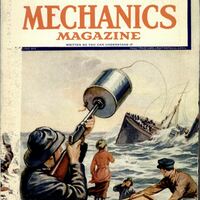 Popular Mechanics, v. 37, n. 1, 1922
Popular Mechanics, v. 37, n. 1, 1922

